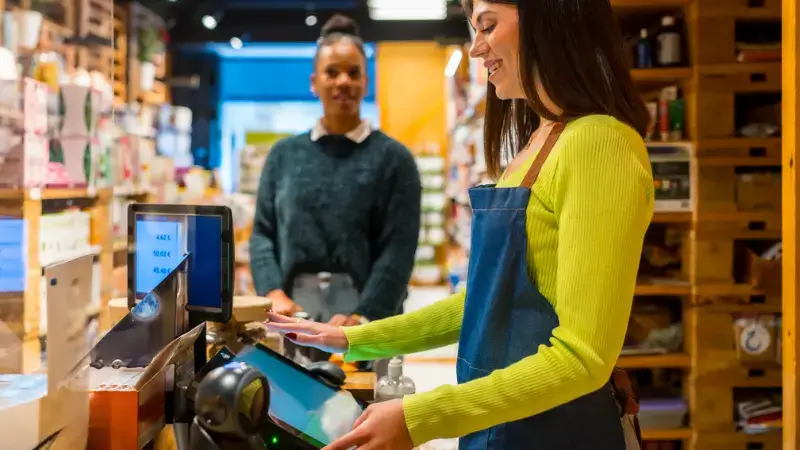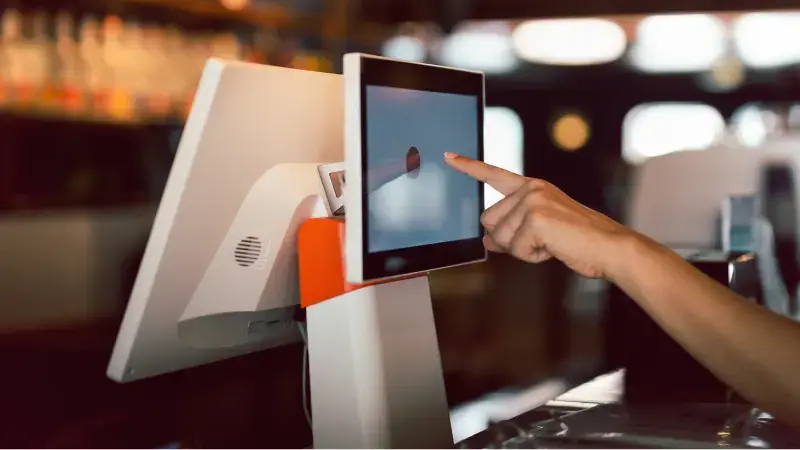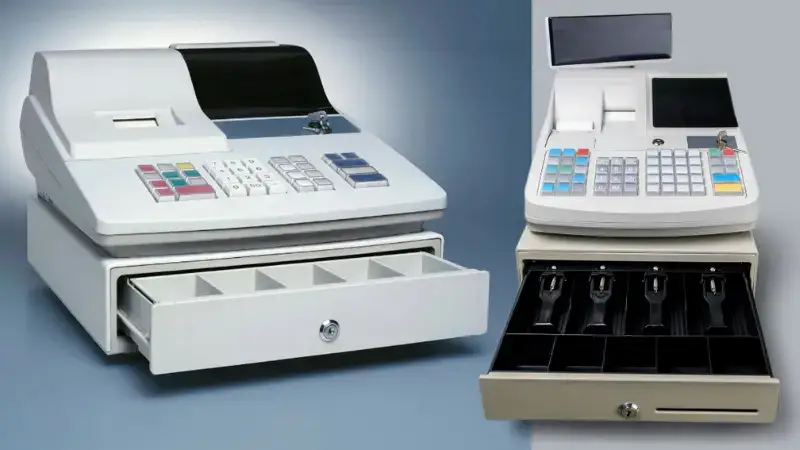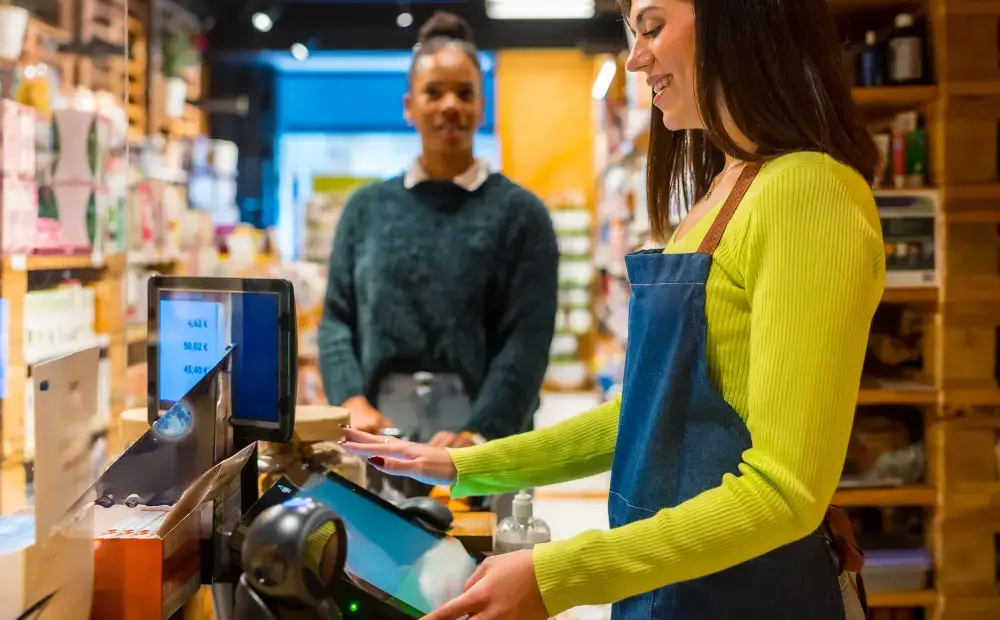Smart Cash Registers = Smarter Business
Slow, outdated checkouts frustrate customers and quietly cost you sales.If you run a small business, speed and accuracy at checkout are critical. That’s why we’ve researched the top cash registers for small businesses, across POS systems and traditional models.We’ve compared features, hardware, pricing, and long-term ROI…so you don’t have to.
This guide helps you choose a small business cash register that improves flow, saves time, and boosts trust.

What Type of Cash Register Fits Your Business?
Your daily operations, sales volume, and sales channels determine what type of cash register you need and what features are essential. According to ThinkLP, 40% of cash discrepancies arise due to human errors, often due to outdated or poorly integrated register systems. You can avoid this loss by simply choosing the right cash register.
So here’s what you need to consider before choosing a cash register:
A. Match the Cash Register to Your Business Type
Each business type has unique operational needs that shape the ideal cash register setup.
- Retail shops need barcode scanners, receipt printers, and real-time inventory tracking.
- Quick-service restaurants benefit from touch screens, modifier buttons, and kitchen printer integration.
- Service providers often need client records, tipping options, and flexible scheduling or pricing tools.
Match your register’s features to your day-to-day operations and then select one. It will save time and reduce errors.
B. Choose Based on Daily Sales Volume

Your daily sales volume should guide the complexity of the system you choose.
- 10–50 sales/day → Basic cash register with simple functions and manual tracking
- 50–200 sales/day → POS register with inventory tracking, staff management, and reporting tools
- 200+ sales/day → Full POS system with multi-terminal support and advanced analytics
Don’t overpay for features you won’t use…or underinvest in tools that can save you hours daily.
C. Do You Need Online and In-Store Sync?
If you sell through physical and digital storefronts, you need a register that talks to both.
- Real-time inventory sync to prevent double-selling
- Order and fulfillment tracking across online and in-store
- Sales data consolidation into one backend system
Without integration, inventory and order management become a bottleneck. Modern POS systems can solve this.
Traditional Cash Register vs POS System: What Should You Choose?

Both systems process payments, but the experience they offer is very different.
However, a Scoop Market study shows that 67% of retailers now use cloud-based POS systems to streamline operations. This shift highlights the preference for modern technology that aligns with evolving business needs and goals.
A. What Is a Traditional Cash Register?
These cash registers are best for basic retail environments with minimal technical needs.
These are all-in-one units with built-in receipt printers, cash drawers, and interfaces. They’re plug-and-play and ideal for cash-only businesses or backup use.
Pros:
- Low upfront cost
- Easy for staff to learn
- Doesn’t rely on the internet or cloud systems
Cons:
- No software flexibility or integrations
- Doesn’t scale with business growth
- There is no support for modern use cases like loyalty programs or remote reporting
Though these registers still serve the purpose, most growing retailers and the solution providers who support them are shifting toward flexible hardware that can evolve alongside their operations.
B. What Is a POS System?
These are best for software providers and integrators needing flexible hardware for dynamic retail setups.
POS-based systems typically involve a combination of software and modular hardware (like a tablet, card reader, receipt printer, and barcode scanner). Many off-the-shelf providers bundle the software and hardware together, limiting your ability to adapt or differentiate the solution.
Important Note:
Many POS brands sell fixed all-in-one systems. But if your business needs custom hardware—like branded kiosks, tamper-proof casings, or setups for multiple locations—SwiftForce’s modular hardware lets you build exactly what works best for your software and customers.
Pros:
- Supports real-time inventory and sales tracking
- Compatible with third-party software
- Enables loyalty programs and CRM features
- Remote access and easy cloud syncing
- Highly adaptable hardware configurations
Cons:
- It may require a stable internet
- Some setups require multiple components and integration
- Initial investment may be higher than traditional models
With a hardware-first approach, your solution becomes the foundation on which software providers can build rather than being locked into rigid, software-controlled ecosystems.
Quick Comparison Table for Traditional Vs POS Cash Registers
| Feature | Traditional Register | POS System | Best For |
|---|---|---|---|
| Connectivity | Offline Only | Online & Offline | Hybrid and Online-ready Stores |
| Functions | Basic Checkout | Inventory, CRM, Reports | Growing or High-volume Shops |
| Cost | One-time Purchase | Subscription + Hardware | Varies (Low to High Investment) |
Must-Have Features for Small Business Cash Registers
A small business cash register has three major objectives: speeding up operations, reducing manual errors, and fulfilling your growing business needs.
Here’s what to focus on when choosing your next system:

A. Payment Processing and Security
Your cash register must handle how your customers want to pay. That means accepting cards, mobile wallets, and newer methods like tap-to-pay or QR codes.
Here’s what you must look for:
- Accept EMV chip cards, mobile wallets (Apple Pay, Google Pay), and tap-to-pay
- Look for PCI-compliant hardware with built-in encryption
- Support for split payments or tipping options if needed
According to McKinsey & Company research conducted in October 2024, almost nine out of ten consumers in the US and Europe use digital payments. If your system can’t support modern payments, you’re creating friction where you can’t afford to.
B. Inventory and Sales Management
Smart systems help you manage stock, staff, and performance. This is where a good POS becomes a business tool, not just a machine.
Here’s what your cash register should do:
- Track item-level inventory and get low-stock alerts.
- Filter sales by product, date, or employee.
- Use barcode scanners to speed up checkout and reduce errors.
- Store sales data securely in the cloud for anytime access.
If you run a retail store or café, this visibility helps you make better buying decisions and avoid stockouts. If your current system can’t track what’s selling, you’re flying blind.
C. Integration and Expandability
You must choose a cash register that works with your current setup and can scale with you.
So, look for these features in a cash register:
- Sync with online platforms like Shopify, Square Online, or WooCommerce.
- Add tools like kitchen printers, customer-facing displays, or loyalty apps.
- Check if it works with your existing cash drawer, receipt printer, or scanner.
Future-proofing your system from day one helps you grow without starting over.
Top Cash Registers for Small Businesses

We’ve compared top-rated systems across two categories: smart POS cash registers and reliable traditional options.
Here’s what stands out in each.
A. Best POS Cash Registers (High-feature, scalable)
These POS systems have modern features like inventory tracking, card payments, and online store support. These cash registers are ideal for growing businesses that want more control. Our best picks are:
- Clover Station Duo
This is best for retail shops, salons, and multi-service businesses with in-store and online sales.
- Two screens: one for staff (14” display), one for customers (08” display)
- Handles card payments, inventory, loyalty, and gift cards
- Compatible with barcode scanners, receipt printers, and cash drawers
- Price: ~$85/month (subscription) or ~$1,899 (one-time). May vary by provider and business needs.
Clover’s system is fast, customizable, and built for businesses that want to scale.
- Square Register
This cash register is best for small retailers and solo operators looking for simplicity and low cost.
- Clean design with two screens and a user-friendly interface
- Accepts all card payments and digital wallets
- Includes free plan for online selling (via Square Online)
- Works with cash drawers, receipt printers, and barcode scanners
- No upfront fee; monthly fees vary based on the plan
Square is ideal for those who want a user-friendly cash register with no upfront risk.
- Toast Countertop Kit
This register is ideal for restaurants, cafés, and food trucks needing kitchen workflows.
- Includes touchscreen POS, cash drawer, receipt/kitchen printer
- Built-in offline mode for handling outages
- Supports pay-at-table, tipping, and split checks
- Pricing includes upfront hardware costs and monthly software fees
Toast offers deep restaurant features that traditional systems can’t match.
B. Best Traditional Cash Registers (Upfront, no subscription)

Traditional cash registers are basic machines with essential functions. These are suitable for small shops with low transaction volume and fixed menus. Our best picks are:
- Sam4s ER-940
If you own a quick-service restaurant, a bakery, or a snack bar, choose Sam4s ER-940.
- Large programmable keyboard for fast order entry
- Comes with a thermal receipt printer and basic stock tracking
- An optional credit card reader can be added
- Pay upfront; no monthly fees
This cash register is practical if you want a reliable, low-maintenance machine.
- Sharp XE-A207
Best for: Gift shops, small retail stores, and seasonal businesses.
- Simple button layout and LCD.
- Accepts optional card reader attachment.
- Includes journal tape for audits and end-of-day summaries.
- Affordable price under $300; no software fees.
The Sharp XE-A207 is a strong choice when you want a durable, user-friendly cash register at an affordable price.
Quick Comparison Table for Best Cash Registers
Here’s a quick comparison of small businesses’ most commonly used systems today. While these are often sold as complete POS solutions, many companies prefer using modular hardware, like desktop terminals or self-service kiosks, that can integrate with their preferred software.
| Register | Best For | Key Features | Accepts Cards | Inventory Management | Price |
|---|---|---|---|---|---|
| Clover Station Duo | Retail + Quick Service | Dual screen, Cloud Sync, Analytics | Built-in | Advanced | $85/mo or $1899 |
| Square Register | Small Retail + Services | Touchscreen, Online Store, App Integrations | Built-in | Standard | $29+/mo |
| Toast Kit | Quick Service Restaurants | Kitchen Printer, Tip Tools, Offline Mode | Built-in | Advanced | $69/mo |
| Sam4s ER-940 | Small Retail + Gift Shops | Large Keyboard, Basic Reports, Receipt Printer | Add-on | Basic | ~$589 |
| Sharp XE-A207 | Low-Volume Retail | Menu-based UI, Tax Functions, Easy Setup | Add-on | Basic | ~$300 |
Hardware Options: What to Look for in Cash Drawers, Screens, and Accessories
Smooth setup, fast and secure operations depend on the hardware of the cash register. So before you invest, you need to evaluate the following components:

A. Cash Drawer & Receipt Printer
Your cash drawer should be lockable and built from heavy-duty steel. Look for models that connect to your POS and open automatically during a transaction.
Regarding receipt printers, choose thermal printers for speed and silence. They’re ideal for retail and restaurants. Use impact printers only if you need carbon copies or receipts in hot or greasy kitchens.
Key considerations:
- Daily transaction volume
- Print speed and paper size compatibility
- Connection type (USB, LAN, or Bluetooth)
B. Touch Screen & Mobile-Friendly Devices
A touch-screen register speeds up training and smooths out checkout. It’s essential for high turnover teams or fast-paced service. Many POS apps work on tablets or smartphones and allow pop-up shops or mobile checkouts to process card payments on the go.
Choose if you need:
- Counter-based checkout with easy navigation
- Portability for markets, events, or remote service
- Fewer physical buttons and better interface clarity
C. Optional Add-ons to Consider
Some POS cash setups support extra tools to streamline sales:
- Barcode scanners to speed up retail
- Kitchen printers to send orders back-of-house
- Customer-facing displays for tip prompts or transparency
- Mobile card readers to accept payments anywhere
Modular hardware lets you scale without starting over. Always check compatibility before buying.
How to Choose the Right Cash Register (A Short Buying Guide)

You don’t need the most expensive system. You need the one that fits your store, customers, and sales volume.
Here’s what you must consider before buying a cash register for your business:
- Business Type and Needs
Retail shops need inventory tracking and barcode scanners. Restaurants should prioritize kitchen printers, tipping, and offline mode.
Service-based businesses benefit from customer tracking and flexible pricing tools.
If you process card payments, make sure that your system supports EMV chips and is PCI compliant. This protects you and your customers.
- Pricing and Ownership
Traditional registers have a one-time purchase price, ideal if you want no ongoing costs. POS systems often have monthly fees but offer more tools. Budget for what makes sense long term.
It’s not about cheap or expensive cash registers, but your business needs. If a cheap one can fulfill your needs, there’s no need to buy the expensive one.
- Long-Term Compatibility
Before you buy, make sure the system is compatible with your existing system, like accounting software, inventory platforms, or your online store. Poor integration creates workarounds that waste time.
Also, check for technical support and software updates. These affect system stability and your ability to fix problems quickly.
Conclusion
The right cash register gives your customers a smoother experience, saves your team time, and improves your business. Whether you go for a traditional register or a modern POS system, make sure it fits your current operations and scales with your goals.
- Go traditional if you want something simple and upfront.
- Go POS if you need features like inventory tracking, online sales sync, or performance analytics.
Ready to Upgrade Your Checkout Game?
Now that you’ve seen the top options, you’re just one wise decision away from improving your workflow and boosting trust at every checkout.If you want to explore better cash register options or need help deciding the best fit, contact Swiforce.



